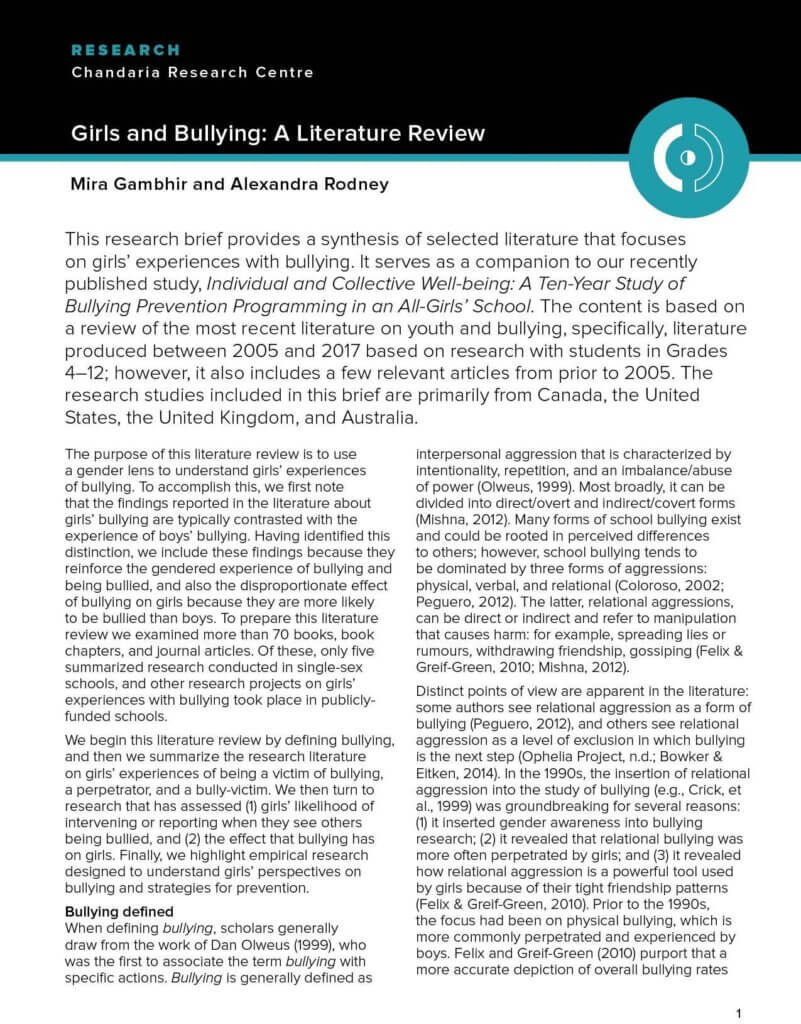Allen, K.P. (2015). “We don’t have bullying, but we have drama”: Understandings of bullying and related constructs within the social milieu of a U.S. high school. Journal of Human Behavior in the Social Environment, 25,159–181.
Batanova, M., Espelage, D.L., & Rao, M.A. (2014). Early adolescents’ willingness to intervene: What roles do attributions, affect, coping, and self-reported victimization play? Journal of School Psychology, 52(3), 279–293.
Bevans, K.B., Bradshaw, C.P., & Waasdorp, T.E. (2013). Gender bias in the measurement of peer victimization: An application of item response theory. Aggressive Behavior 39(5), 370–380.
Boak, A., Hamilton, H.A., Adlaf, E.M., Henderson, J.L., & Mann, R.E. (2015). The mental health and wellbeing of Ontario students, 1991–2015: Detailed OHDUHS findings. CAMH Research Document Series, No. 43. Toronto, ON: Centre for Addiction and Mental Health.
Bowker, J., & Etkin, E. (2014). Does humor explain why relationally aggressive adolescents are popular? Journal of Youth Adolescence, 43(8), 1322.
Cénat, J.M., Blais, M., Hébert, M., Lavoie, F., & Guerrier, M. 2015. Correlates of bullying in Quebec high school students: The vulnerability of sexual-minority youth. Journal of Affective Disorders, 183, 315.
Crick, N.R., Werner, N.E., Casas, J.F., O’Brien, K.M., Nelson, D.A., Grotpeter, J.K., & Markon, K. (1999). Childhood aggression and gender: A new look at an old problem. In D. Bernstein (Ed.), Nebraska symposium on motivation: Gender and motivation (pp. 75–141). Lincoln, NE: University of Nebraska Press.
Coloroso, B. (2002). The bully, the bullied and the bystander. Toronto: Harper Collins Publishers Ltd.
Dane, A.V., Marini, Z.A., Volk, A.A., & Vaillancourt, T. (2017). Physical and relational bullying and victimization: Differential relations with adolescent dating and sexual behavior. Aggressive Behavior, 43(2), 111–122.
Dunn, H.K., Gjelsvik, A., Pearlman, D.N., & Clark, M.A. (2014). Association between sexual behaviors, bullying victimization and suicidal ideation in a national sample of high school students: Implications of a sexual double standard. Women’s health issues: Official publication of the Jacobs Institute of Women’s Health, 24(5), 567–574.
Evaldsson, A-C., & Svahn, J. (2012. School bullying and the micro-politics of girls’ gossip disputes. In S. Danby & M. Theobald (Ed.), Disputes in everyday life: Social and moral orders of children and young people (pp. 297–323), Sociological Studies of Children and Youth, 15. Bingley, U.K.: Emerald Group Publishing Limited.
Felix, E.D., & Greif-Green, J.(2010). Popular girls and brawny boys. In S.R. Jimerson, S.M. Swearer, & D.L. Espelage (Eds.), Handbook of bullying in schools: An international perspective (pp. 173–185). New York: Routledge.
Goldammer, L., Swahn, M.H., Strasser, S.M., Ashby, J.S., & Meyers, J. (2013). An examination of bullying in Georgia schools: Demographic and school climate factors associated with willingness to intervene in bullying situations. The Western Journal of Emergency Medicine, 14(4), 324–328.
Hymel, S., & Swearer, S.M. (2015). Four decades of research on school bullying: An introduction. American Psychologist, 70(4), 300–310.
Jamal, F., Bonell, C., Harden, A., & Lorenc, T.(2015). The social ecology of girls’ bullying practices: Exploratory research in two London schools. Sociology of Health and Illness, 37(5), 731–744.
Jenkins, L.N., & Demaray, M.K. (2015). Indirect effects in the peer victimization-academic achievement relation: The role of academic self-concept and gender. Psychology in the Schools, 52(3), 235–247.
Jenkins, L.N.,& Fredrick, S.S.(2017). Social capital and bystander behavior in bullying: Internalizing problems as a barrier to prosocial intervention. Journal of Youth and Adolescence, 46(4), 757–771.
Jenkins, L.N., & Nickerson, A.B. (2017). Bullying participant roles and gender as predictors of bystander intervention. Aggressive Behavior, 43(3), 281–290.
Jenkins, L.N., Demaray, M.K., Fredrick, S.S., & Summers, K.H. (2016). Associations among middle-school students’ bullying roles and social skills. Journal of School Violence, 15(3), 259–20.
Jenkins, L.N., Demaray, M.K., & Tennant, J. (2017). Social, emotional, and cognitive factors associated with bullying. School Psychology Review, 46(1), 42–64.
Johnson, D., & Gastic, B. (2014). Patterns of bullying in single-sex schools. Sexuality Research and Social Policy, 11(2), 126–136.
Lambe, L.J., Chloe C.H., Craig, W.M., & Pepler, D.J. (2017). Does defending come with a cost? Examining the psychosocial correlates of defending behaviour among bystanders of bullying in a Canadian sample. Child Abuse & Neglect, 65, 112–123.
Landstedt, E., & Persson, S. (2014). Bullying, cyberbullying, and mental health in young people. Scandinavian Journal of Public Health, 42(4), 393–399.
Lansu, T.A.M., Cillessen, A.H.N., & Bukowski, W.M. (2013). Implicit and explicit peer evaluation: Associations with early adolescents’ prosociality, aggression, and bullying. Journal of Research on Adolescence, 23(4), 762–771.
Mishna, F.(2012). Bullying: A guide to research, intervention, and prevention. Oxford: Oxford University Press.
Mishna, F., Khoury-Kassabri, M., Gadalla,T., & Daciuk, D. (2012). Risk factors for involvement in cyber bullying: Victims, bullies and bully-victims. Children and Youth Services Review 34(1), 63–70.
Nickerson, A.B., & Mele-Taylor, D. 2014a. Empathetic responsiveness, group norms, and prosocial affiliations in bullying roles. School Psychology Quarterly: The Official Journal of the Division of School Psychology, American Psychological Association, 29(1), 99–109.
Nickerson, A.B., & Mele-Taylor, D. (2014)b. Influence of gender, empathy, group norms, and prosocial affiliations on bullying roles. School Psychology Quarterly, 29, 99–109.
Olweus, D. (1999). Sweden. In P.K. Smith, Y. Morita, J. Junger-Tas, D. Olweus, R. Catalano, & P. Slee (Eds.), The nature of school bullying: A cross-national perspective (pp. 7–27). New York: Routledge.
Ophelia Project (n.d.) What is relational aggression, bullying, and cyberbullying? Retrieved from http://www.opheliaproject.org/ra.html#ra
Peguero, A.A. (2012). Schools, bullying, and inequality: Intersecting factors and complexities with the stratification of youth victimization at school. Sociology Compass 6(5), 402–412.
Pepler, D., & Craig, W. (2012). Healthy development depends on healthy relationships. Paper prepared for the Division of Childhood and Adolescence, Centre for Health Promotion, Public Health Agency of Canada.
Pepler, D., & Craig, W. (2014). Trends in healthy development and healthy relationships. Paper prepared for the Division of Childhood and Adolescence, Centre for Health Promotion, Public Health Agency of Canada.
Rueger, S.Y., & Jenkins, L.N. (2014). Effects of peer victimization on psychological and academic adjustment in early adolescence. School Psychology Quarterly, 29(1), 77.
Schneider, S.K., O’Donnell, L., & Smith, E. 2015. Trends in Cyberbullying and school bullying victimization in a regional census of high school students, 2006-2012. Journal of School Health, 85(9), 611-620.
Sokol, N., Bussey, K., & Rapee, R. (2016). Victims’ responses to bullying: The gap between students’ evaluations and reported responses. School Mental Health, 8(4), 461–475.
Solberg, M.E., Olweus, D., & Endresen, I.M. (2007). Bullies and victims at school: Are they the same pupils? British Journal of Educational Psychology, 77(2), 441–464.
Statistics Canada. (2017). Women in Canada: A gender-based statistical report: The girl child. Ottawa, ON: Ministry of Industry. Catalogue no. 89-503-X.
U.S. Department of Education. (2016). Student reports of bullying: Results from the 2015 School Crime Supplement to the National Crime Victimization Survey. Web Tables. December. NCES 2017-015.








